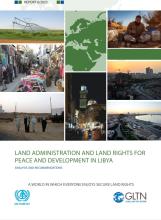Land Library Search
Welcome to the Land Portal Library. Explore our vast collection of open-access resources (over 74,000) including reports, journal articles, research papers, peer-reviewed publications, legal documents, videos and much more.
/ library resources
Showing items 1 through 9 of 2149.This report is a contribution towards the improvement of land management and land administration in Libya.
To ensure a better and more sustainable future for all, the 2030 Agenda for Sustainable Development (“the 2030 Agenda”) has identified 17 Sustainable Development Goals (SDGs) to be achieved by 2030.
The Global Land Indicators Initiative (GLII) platform was established in 2012 through the joint effort of United Nations Human Settlements Programme (UN-Habitat), the World Bank and Millennium Challenge Corporation with the aim of making global-scale monitoring of land governance a reality by 202
The Qinghai-Tibet Plateau (QTP) is an area sensitive to global climate change, and land use/land cover change (LUCC) plays a vital role in regulating climate system at different temporal and spatial scales.
Woodland expansion on a significant scale is widely seen to be critical if governments are to achieve their net zero greenhouse gas ambitions. The United Kingdom government is committed to expanding tree cover from 13% to at least 17% in order to achieve net zero by 2050.
Over the last few decades, interaction and collaboration with stakeholders and communities in the design and development of our environment have become integral parts of landscape architecture practice.
Suburban rural landscape multifunction has received increasing attention from scholars due to its high demand and impact on main urban areas. However, few studies have been focused on suburban rural landscape multifunction because of data constraints.
This study assesses the global mountain population, population change over the 1975–2015 time-range, and urbanisation for 2015.
The expansion of urban areas around the world and the application of the sustainability paradigm to tourism discourses has favored an increase in the number of people visiting natural protected areas (NPAs) in their leisure time.



